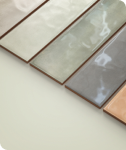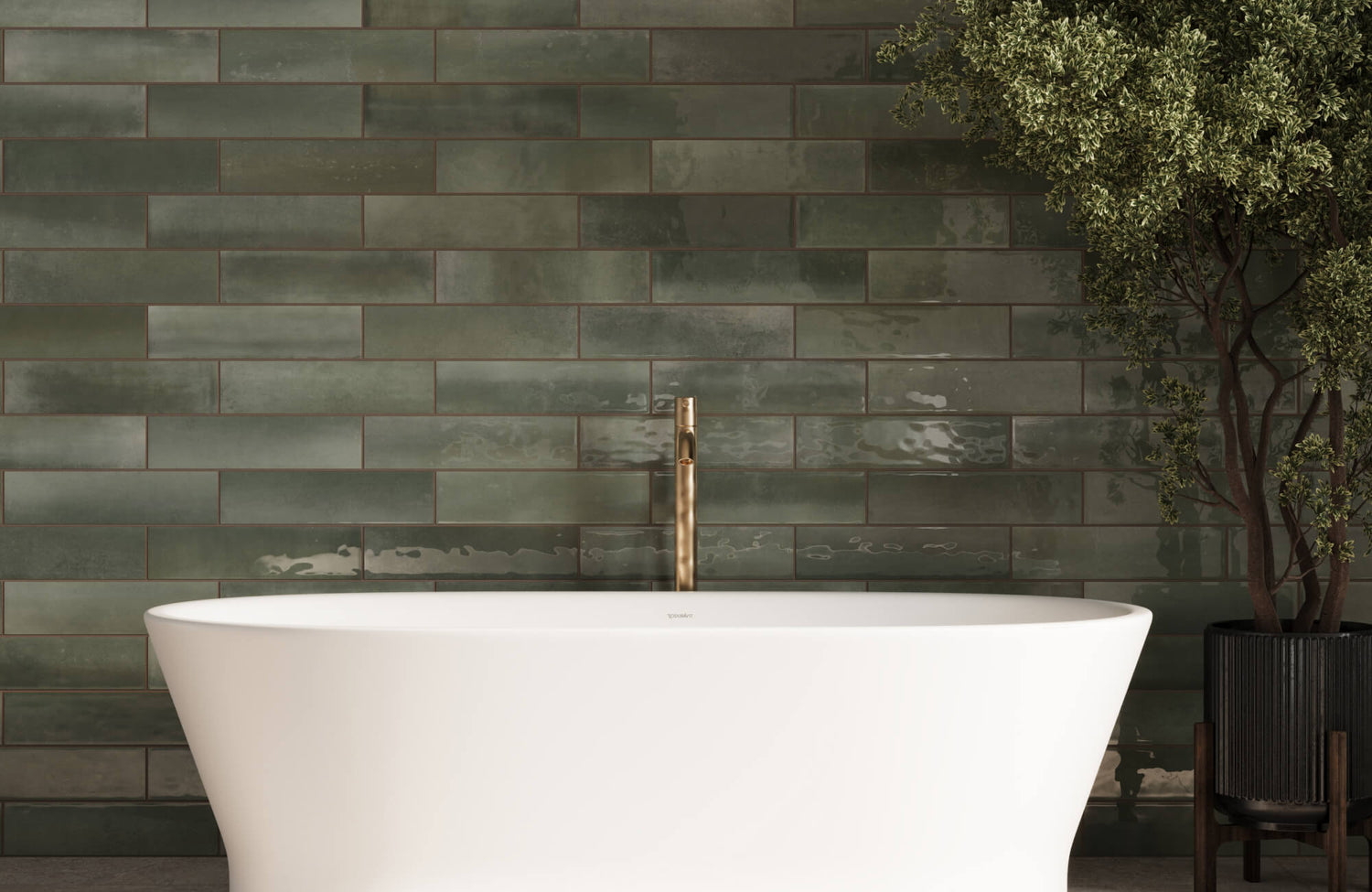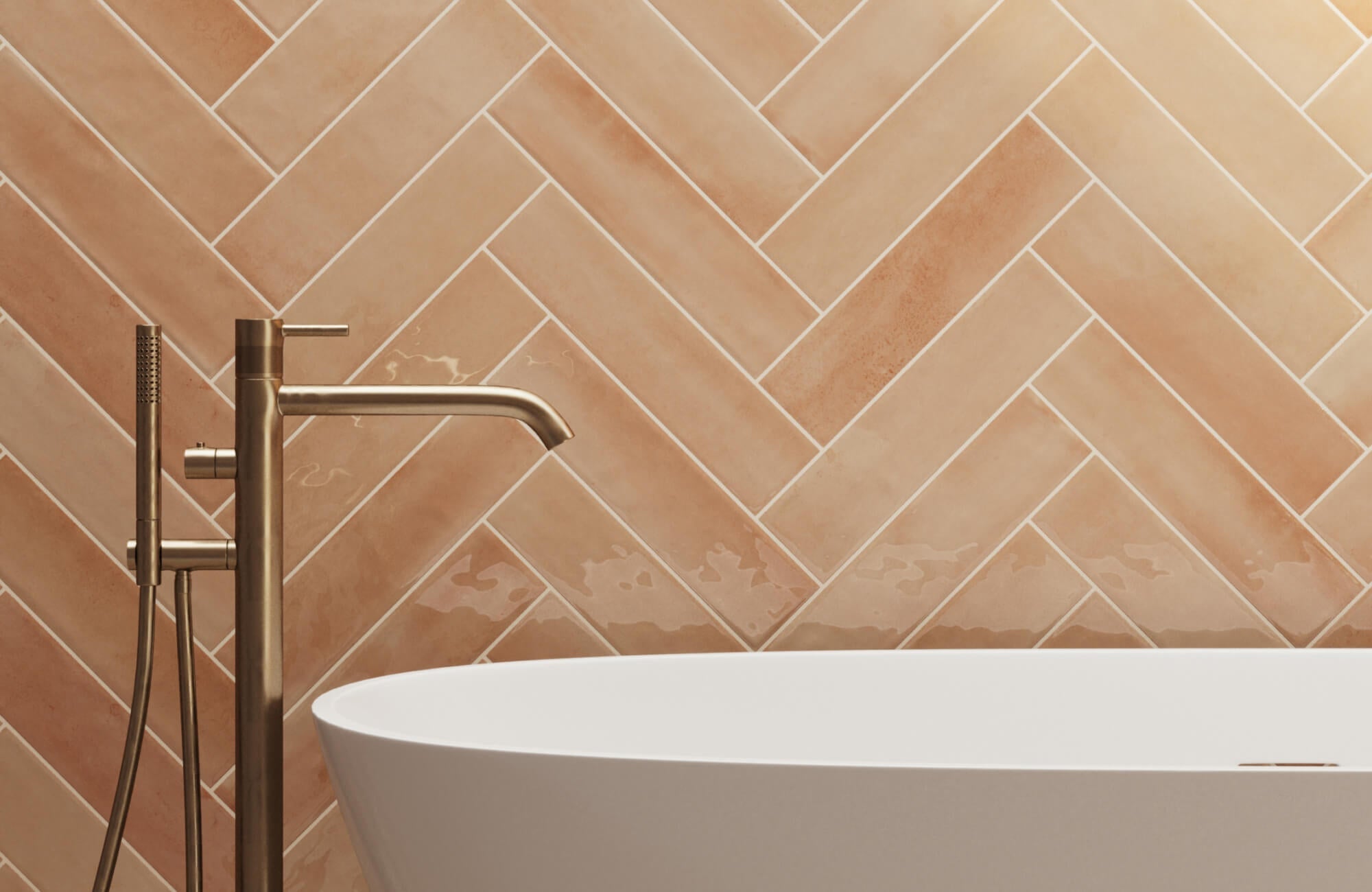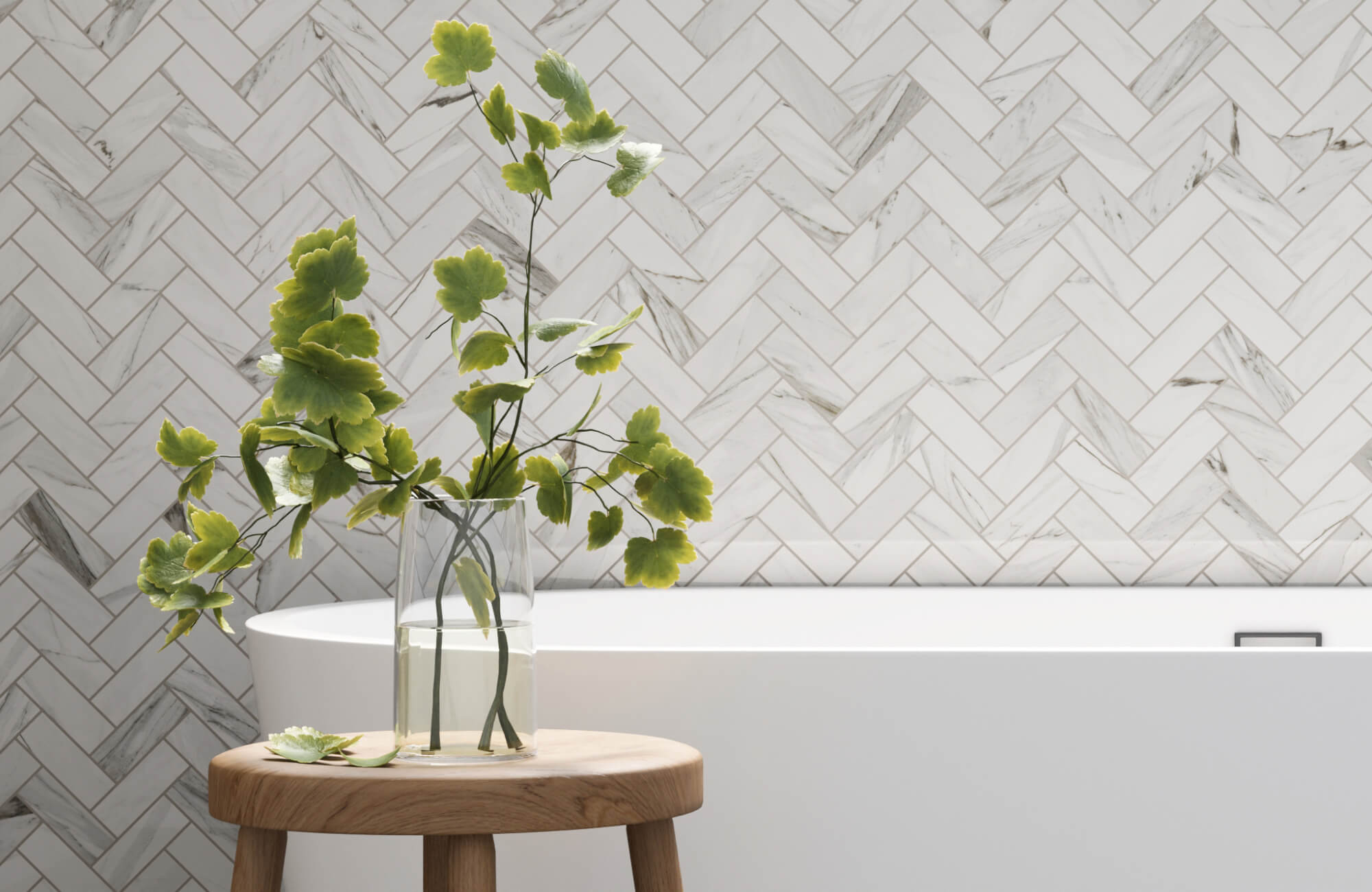Originally made famous by New York City’s subway system, subway tiles have come a long way from their utilitarian beginnings. Today, they’re a design staple recognized for their clean lines, long-lasting durability, and timeless charm that suits a wide range of styles.
In this guide, we’ll explore the many ways subway tiles can be used throughout the home. From classic kitchen backsplashes to creative accent walls and even furniture features, you’ll find plenty of inspiration to help you incorporate these versatile tiles into your space with confidence and style.

The Enduring Appeal of Subway Tiles
Subway tiles, such as our Chantel 3x12 Matte Porcelain Tile in Imperial above, have earned their place as a design classic, balancing form and function in spaces of all kinds. From their historic beginnings in public transit stations to their modern-day popularity in homes, their charm lies in their clean lines, versatility, and ease of use. Whether you're drawn to their vintage character or their sleek simplicity, subway tiles offer a timeless foundation that works across styles and settings.
A Brief History of Subway Tiles
Subway tiles were first introduced in the early 1900s in New York City’s underground subway system. Designers chose them for their glazed surface, which made stations brighter, easier to clean, and more welcoming. Laid in a running bond pattern, these rectangular tiles created a sense of visual rhythm and spaciousness. What started as a utilitarian choice soon became a beloved design feature used far beyond transit tunnels.
Durability and Easy Maintenance
One of the key reasons subway tiles remain a favorite is their durability. Porcelain and ceramic versions are especially well-suited for busy areas like kitchens, bathrooms, and laundry rooms. Their non-porous surfaces resist stains, moisture, and everyday wear, making them simple to clean with a quick wipe. This low-maintenance quality adds long-term value to any space.
Versatility in Style and Layout
Despite their simple rectangular shape, subway tiles offer endless styling options. From the traditional running bond to stacked, herringbone, or vertical layouts, they adapt beautifully to both classic and modern aesthetics. They also come in a wide range of colors and finishes, from bright whites to bold hues or glossy to matte. This flexibility makes them a reliable choice for everything from subtle backdrops to bold design statements.
A Budget-Friendly Choice
Subway tiles are known not just for their charm, but also for their cost-effectiveness. Compared to materials like marble or hand-cut mosaics, they’re a much more affordable option, without sacrificing visual impact. Their accessibility makes it easy to tile large areas without stretching your budget. For homeowners or designers working within cost limits, subway tiles deliver impressive results at a practical price point.

Classic Applications for Subway Tiles
Subway tiles have become a staple in some of the most frequently used areas of the home, thanks to their timeless style, durability, and easy maintenance. Whether you're renovating a kitchen, upgrading a bathroom, or refreshing a laundry room, these tiles offer a clean, versatile backdrop that works across design styles. Their ability to combine beauty with function makes them an ideal choice for everyday spaces that deserve both form and practicality.
Kitchens
The kitchen backsplash is one of the most classic and practical uses for subway tiles. Their smooth, easy-to-clean surface protects against splashes while bringing visual interest to the space. The traditional running bond layout adds subtle texture without overwhelming the design, while modern alternatives like horizontal or vertical stacking offer a cleaner, more contemporary aesthetic.
Subway tiles also work beautifully as accent walls. Extend them behind open shelving or frame focal points like your sink or range to tie the entire kitchen together. If you cook frequently, consider using darker grout behind the stovetop to help mask splatter, or even install a mosaic tile section in that zone for easier cleanup. Whether your kitchen leans modern, farmhouse, or transitional, subway tiles offer a reliable and flexible foundation.
Bathrooms
Subway tiles are a natural fit for bathrooms, offering both function and style in high-moisture areas. In showers, they create a bright, clean look that enhances natural light and makes the space feel larger. While white tiles remain a go-to, experimenting with colors or finishes can give your bathroom a more personalized, spa-like atmosphere.
Outside the shower, subway tiles can be used as wall cladding or wainscoting to protect against splashes and simplify cleaning. A chair rail or trim detail at the transition adds polish and visual interest. For a touch of style, tile an accent wall behind your vanity to frame mirrors, lighting, and fixtures, creating a standout feature in a typically utilitarian space.
Laundry Rooms
The laundry room may not be the first place you think to use subway tiles, but it's one of the most practical. A tiled backsplash behind your washer and dryer keeps walls protected from moisture, detergent splashes, and everyday mess. It also gives the room a more intentional, finished look that complements modern appliances and cabinetry. As seen with our Madilyn 3x12 Glossy Ceramic Tile in Pearl above, this tile brings a fresh, polished backdrop to hardworking spaces like laundry areas.
You can take it a step further by installing subway tiles along the lower portion of the walls, especially in areas prone to contact with laundry baskets or damp clothes. This makes often-used zones easier to maintain while bringing visual consistency to the space. Whether your laundry room is large or compact, subway tiles can help it feel more polished, functional, and aligned with the rest of your home's design.

Creative Uses for Subway Tiles
Subway tiles aren't limited to kitchens and bathrooms, they’re just as effective in unexpected places throughout the home. With their durability, easy upkeep, and endless layout options, these tiles offer the perfect mix of style and function. Whether you're highlighting a small area or reimagining a forgotten space, subway tiles bring design versatility wherever they’re used.
Entryways and Mudrooms
Your entryway or mudroom sets the tone for the rest of your home, so why not make it both practical and beautiful? Subway tiles are a smart way to add style while protecting the walls from everyday wear. Their easy-to-clean surface makes them ideal for busy areas that deal with muddy shoes, backpacks, or pet gear.
A popular approach is tiling the lower half of the wall. This acts as a wipeable barrier that guards against scuffs, moisture, and dirt. For added durability and a bit of visual depth, choose a darker grout color that helps mask signs of use over time. It’s a subtle design move that can make your space feel both polished and lived-in.
You can also use subway tiles to create a bold accent wall near the entry. Try a striking color like cobalt, emerald, or mustard to energize the space, or go for a geometric or herringbone pattern for texture. Finish the look by adding hooks or open shelving directly to the tiled surface, giving you both storage and style in one hardworking zone.
Fireplaces
Subway tiles can completely transform the look of your fireplace, taking it from a standard feature to a true centerpiece. Whether you’re framing the firebox or tiling the full surround, these tiles add clean lines and a sleek finish that pairs beautifully with any interior style. Glossy options with beveled edges can even reflect firelight for a subtle glow.
For a traditional yet polished look, the running bond pattern remains a classic. It works especially well with white or cream tiles, offering a timeless backdrop that balances rustic mantels and modern finishes alike. You can even use a soft gray grout to add definition while keeping the overall effect calm and cohesive.
If you prefer something more eye-catching, the herringbone layout brings a sense of movement and depth. It’s especially effective with smaller tile sizes, adding intricate detail without overwhelming the space. A herringbone subway tile fireplace is perfect for living rooms that blend comfort with contemporary design.
Accent Walls
Subway tiles are ideal for creating accent walls that add personality to different rooms in your home. In dining rooms, they make a striking backdrop behind a buffet or console, anchoring the space and adding texture without overwhelming the rest of the decor. Choose bold grout or patterned tiles to take the look up a notch.
In living rooms, consider using subway tiles to highlight a fireplace or frame artwork. A tiled wall behind your favorite print or gallery arrangement adds a curated, high-end touch while keeping the overall aesthetic clean and structured. You can mix tile styles and accessories to reflect your personal taste and build visual interest.
Even bedrooms can benefit from a well-placed subway tile accent wall. Try tiling the wall behind your bed to give it the effect of a built-in headboard. Soft tones like muted blue or taupe keep the space restful, while subtle textures or alternative layouts like basketweave or stacked vertical tiles add quiet sophistication.
Unexpected Applications
Beyond walls and backsplashes, subway tiles can be used in surprising ways to enhance everyday surfaces. One creative idea is using tiles on furniture, like the top of a coffee table or console. Smaller tile sizes work best for this, creating a sturdy, decorative surface that’s easy to maintain with proper sealing.
You can also elevate your home bar area with a tiled backdrop. This not only protects the wall from splashes but also helps define the space visually. Try mixing materials like glass or metallic-finish subway tiles to add a bit of sparkle and create a welcoming atmosphere for guests.
Another standout application is stair risers. Tiling the vertical face of each step adds a layer of charm while protecting against scuffs and wear. Consider a patterned layout or subtle color shifts from step to step to bring a playful, custom feel to your hallway or entry. Always choose slip-resistant finishes and finish edges cleanly for a safe, polished result.

Choosing the Right Subway Tile
With so many materials, colors, and patterns available, selecting the right subway tile can feel like a big decision. But once you understand the essentials, it becomes a creative opportunity rather than an overwhelming task. By focusing on your space’s needs and your personal style, you can confidently choose a tile that blends form with function.
Material Considerations
The material you select will shape both the appearance and performance of your subway tiles. Ceramic, as seen above with our Olivia 4x16 Glossy Ceramic Tile in Sage, remains a classic choice thanks to its affordability, wide range of finishes, and ease of use. It's ideal for lower-moisture areas and general wall applications, though it may require occasional sealing in wet spaces like showers due to its slightly porous surface.
If durability is a priority, porcelain offers an upgrade. Denser and less porous than ceramic, porcelain tiles are better suited for high-moisture or busy areas, such as bathrooms and kitchen backsplashes. They're more resistant to scratches and stains and typically don’t require sealing, making them a low-maintenance solution for busy households.
For a more luxurious look, natural stone tiles like marble or granite deliver unmatched elegance. These materials are especially striking in fireplace surrounds or behind cooktops, where heat resistance matters. However, they do require more upkeep, including regular sealing and careful cleaning to protect the surface from stains or etching over time.
Color and Pattern Options
Color plays a major role in setting the tone of your space, and subway tiles come in a wide range of hues to match every style. Classic white is always a safe and timeless choice, brightening rooms and helping them feel more spacious. You can choose between cool or warm tones of white to coordinate with your overall palette or mix slight variations for added depth.
For something more expressive, colored subway tiles offer endless creative possibilities. Deep blues, greens, or terracotta tones make stunning accent walls, while softer shades like sage or blush add character without overwhelming the space. Think about how the tile color interacts with lighting and nearby surfaces to maintain balance throughout the room.
You can also explore patterns to bring subtle texture or bold personality into your design. A traditional running bond is clean and timeless, while herringbone, basketweave, or vertical stacks introduce movement and structure. Patterned subway tiles, such as those with geometric or textured finishes, can be used alone or mixed with solid tiles for a more personalized touch.
See Your Vision Come to Life
Once you’ve explored the options, the best way to move forward is to visualize them in your actual space. With Edward Martin’s AR Tool, you can preview different subway tile finishes, colors, and layouts on your walls before making a final decision. It’s an easy way to experiment, gain confidence, and bring your design vision to life, one tile at a time.

Installation Tips and Considerations
Installing subway tiles can be a satisfying way to personalize your space, whether you're updating a backsplash or adding a new accent wall. With the right preparation and approach, it’s a project that can yield professional-looking results, even for first-time DIYers. Below, we’ll walk through key decisions and care tips to help you plan and maintain a tile installation that lasts.
Hiring a Professional Tiler vs. DIY Installation
Before getting started, it’s important to consider whether you want to take on the installation yourself or hire a professional. Your decision should depend on the scale of your project, the tile layout complexity, and your overall comfort with tools and hands-on work. Smaller, straightforward spaces can often be handled with a DIY approach, while larger or more detailed projects may benefit from expert support.
For confident DIYers, installing subway tiles can be a fun and rewarding experience, especially in spaces like backsplashes or accent walls with simple layouts. Just be sure to gather all necessary tools, prep your surfaces properly, and follow a measured layout plan. Online tutorials and how-to guides can be valuable resources, helping you build the skills needed to complete the job with precision.
If your project involves intricate tile patterns, uneven walls, or large surface areas, bringing in a professional can save you time and stress. A skilled tiler will manage everything from substrate preparation to clean grout lines and aligned cuts. While hiring a pro comes with a higher upfront cost, it also ensures a polished result that holds up over time, making it a worthwhile investment for key spaces in your home.
Keeping Subway Tiles Looking Their Best
One of the biggest advantages of subway tiles is how easy they are to care for, especially in heavily used areas like kitchens and bathrooms. To keep them looking fresh, make a habit of wiping down tiled surfaces regularly with a soft microfiber cloth and a gentle cleaning solution. This helps prevent buildup from grease, fingerprints, and everyday messes.
For more stubborn grime, consider the type of stain and adjust your cleaning method accordingly. Grease and soap scum can often be tackled with household staples like baking soda or diluted white vinegar. Just be sure to avoid harsh chemicals that may damage the surface or grout, especially when working with delicate materials like natural stone.
Some types of tile, particularly stone or unglazed ceramic, may require periodic sealing to resist stains and moisture. Always refer to the manufacturer’s recommendations for cleaning and maintenance specific to your tile material. With the right care routine, subway tiles can retain their appearance and performance for years to come.
Transform Your Space with a Timeless Touch
What began in the New York City subway has evolved into one of the most beloved design staples in modern interiors. Subway tiles continue to stand the test of time thanks to their versatility, durability, and classic appeal. From kitchens and bathrooms to entryways, fireplaces, and even furniture, they offer countless opportunities to add character, structure, and function to every corner of your home.
Whether you’re taking on a DIY update or working with a pro, subway tiles provide a flexible and approachable way to bring your ideas to life. With so many styles, materials, and layouts to choose from, your space can reflect exactly what you want it to feel like—timeless, practical, and uniquely yours. If you’re ready to get started or want help selecting the right tile, contact us today or explore your options through our personalized design consultation.







